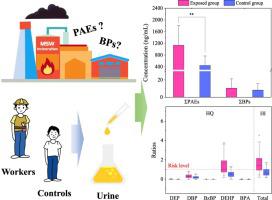Environment International ( IF 10.3 ) Pub Date : 2020-09-06 , DOI: 10.1016/j.envint.2020.106101 Shaoyou Lu 1 , Dongfeng Yang 2 , Xiang Ge 3 , Le Li 4 , Yang Zhao 1 , Chun Li 1 , Shengtao Ma 3 , Yingxin Yu 3

|
Many hazardous substances can be released during incineration of municipal solid waste (MSW), which pose a potential threat to human health. As additives, phthalates (PAEs) and bisphenols (BPs), which are widely used in daily goods, are likely to be present in the released hazardous substances. In the present study, we investigated the urinary levels of phthalate metabolites (mPAEs) and BPs in workers in an MSW incineration plant (the exposed group) and in residents 8 km away (the control group) in Shenzhen, China. The results showed that the median total urinary concentration of mPAEs in workers was significantly higher than that in residents (1.02 × 103 vs. 375 ng/mL). However, there was no significant difference between workers and residents for BPs. Among the mPAEs measured, the most abundant compound was mono-n-butyl phthalate in both exposed and control groups. Monoethyl phthalate and monomethyl phthalate might be potential markers for MSW incineration because of significantly high levels in the exposed group. The workers engaged in different types of workshops showed no significant differences in the urinary levels of mPAEs, also for BPs. It was worth noting that 70.8% of workers were at risk of the non-carcinogenic effects caused by PAEs with diethylhexyl phthalate having the highest risk. Actions should be taken to reduce the risks caused by these hazardous chemicals.
中文翻译:

废物焚烧厂工人的邻苯二甲酸酯代谢物和双酚的内部暴露以及相关的健康风险。
焚化城市固体废物(MSW)期间会释放出许多有害物质,这对人类健康构成潜在威胁。作为添加剂,广泛用于日用品中的邻苯二甲酸酯(PAE)和双酚(BP)可能存在于释放的有害物质中。在本研究中,我们调查了深圳城市生活垃圾焚烧厂(暴露组)和8公里外的居民(对照组)工人中邻苯二甲酸酯代谢物(mPAE)和血压的尿水平。结果显示,工人中mPAE的总尿中位数显着高于居民(1.02×10 3vs.375 ng / mL)。但是,BP的工人和居民之间没有显着差异。在测得的mPAE中,暴露组和对照组中最丰富的化合物是邻苯二甲酸单正丁酯。邻苯二甲酸单乙酯和邻苯二甲酸单甲酯可能是城市生活垃圾焚化的潜在标志物,因为暴露人群中的含量很高。参加过不同类型工作坊的工人的mpaEs尿水平和BPs均无显着差异。值得注意的是,有70.8%的工人处于PAE引起的非致癌作用的风险中,邻苯二甲酸二乙基己酯的风险最高。应采取措施减少这些有害化学物质引起的风险。











































 京公网安备 11010802027423号
京公网安备 11010802027423号